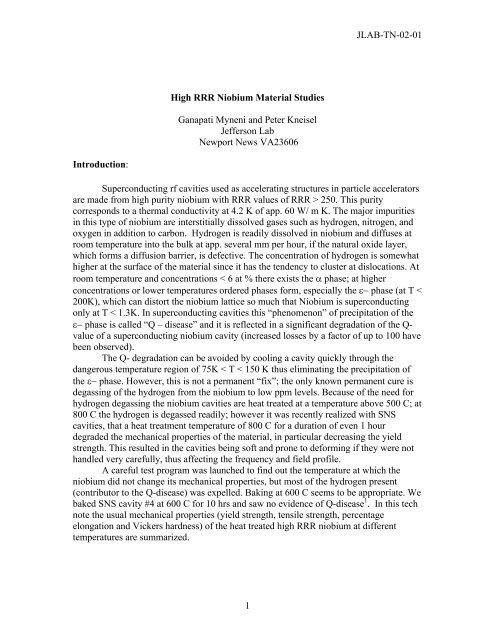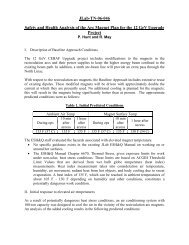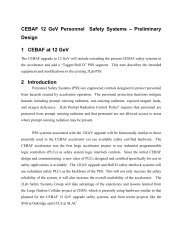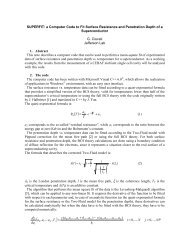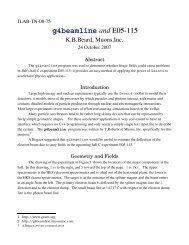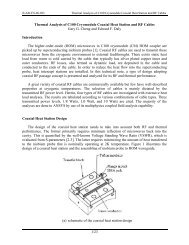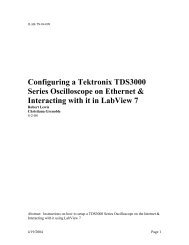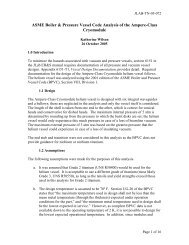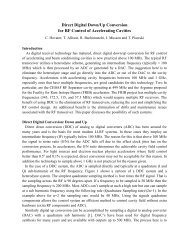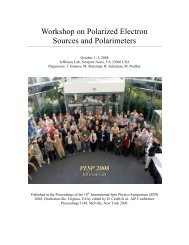JLAB-TN-02-01 High RRR Niobium Material Studies Ganapati ...
JLAB-TN-02-01 High RRR Niobium Material Studies Ganapati ...
JLAB-TN-02-01 High RRR Niobium Material Studies Ganapati ...
Create successful ePaper yourself
Turn your PDF publications into a flip-book with our unique Google optimized e-Paper software.
<strong>JLAB</strong>-<strong>TN</strong>-<strong>02</strong>-<strong>01</strong><br />
<strong>High</strong> <strong>RRR</strong> <strong>Niobium</strong> <strong>Material</strong> <strong>Studies</strong><br />
<strong>Ganapati</strong> Myneni and Peter Kneisel<br />
Jefferson Lab<br />
Newport News VA23606<br />
Introduction:<br />
Superconducting rf cavities used as accelerating structures in particle accelerators<br />
are made from high purity niobium with <strong>RRR</strong> values of <strong>RRR</strong> > 250. This purity<br />
corresponds to a thermal conductivity at 4.2 K of app. 60 W/ m K. The major impurities<br />
in this type of niobium are interstitially dissolved gases such as hydrogen, nitrogen, and<br />
oxygen in addition to carbon. Hydrogen is readily dissolved in niobium and diffuses at<br />
room temperature into the bulk at app. several mm per hour, if the natural oxide layer,<br />
which forms a diffusion barrier, is defective. The concentration of hydrogen is somewhat<br />
higher at the surface of the material since it has the tendency to cluster at dislocations. At<br />
room temperature and concentrations < 6 at % there exists the α phase; at higher<br />
concentrations or lower temperatures ordered phases form, especially the ε− phase (at T <<br />
200K), which can distort the niobium lattice so much that <strong>Niobium</strong> is superconducting<br />
only at T < 1.3K. In superconducting cavities this “phenomenon” of precipitation of the<br />
ε− phase is called “Q – disease” and it is reflected in a significant degradation of the Q-<br />
value of a superconducting niobium cavity (increased losses by a factor of up to 100 have<br />
been observed).<br />
The Q- degradation can be avoided by cooling a cavity quickly through the<br />
dangerous temperature region of 75K < T < 150 K thus eliminating the precipitation of<br />
the ε− phase. However, this is not a permanent “fix”; the only known permanent cure is<br />
degassing of the hydrogen from the niobium to low ppm levels. Because of the need for<br />
hydrogen degassing the niobium cavities are heat treated at a temperature above 500 C; at<br />
800 C the hydrogen is degassed readily; however it was recently realized with SNS<br />
cavities, that a heat treatment temperature of 800 C for a duration of even 1 hour<br />
degraded the mechanical properties of the material, in particular decreasing the yield<br />
strength. This resulted in the cavities being soft and prone to deforming if they were not<br />
handled very carefully, thus affecting the frequency and field profile.<br />
A careful test program was launched to find out the temperature at which the<br />
niobium did not change its mechanical properties, but most of the hydrogen present<br />
(contributor to the Q-disease) was expelled. Baking at 600 C seems to be appropriate. We<br />
baked SNS cavity #4 at 600 C for 10 hrs and saw no evidence of Q-disease 1 . In this tech<br />
note the usual mechanical properties (yield strength, tensile strength, percentage<br />
elongation and Vickers hardness) of the heat treated high <strong>RRR</strong> niobium at different<br />
temperatures are summarized.<br />
1
<strong>JLAB</strong>-<strong>TN</strong>-<strong>02</strong>-<strong>01</strong><br />
Mechanical Properties:<br />
Mechanical properties of high purity niobium have been extensively investigated<br />
at <strong>JLAB</strong> during the period 1988 through 1994, and a summary of this database was<br />
presented at the DESY TESLA Workshop, in March 1995, on Cavity Fabrication<br />
Techniques at the request of workshop organizers 2 . Most of our work carried out at<br />
<strong>JLAB</strong> was published in various reports and is summarized here for reference. Ambient<br />
and cryogenic mechanical properties of the as-received CEBAF production niobium<br />
including the reactor grade (Cabot) and high <strong>RRR</strong> niobium (Teledyne Wah Chang,<br />
Heraeus and Fansteel) were presented on invitation at the 1990 State of the Art Electron<br />
Beam Melting and Refining Conference 3 .<br />
Extensive cryogenic mechanical properties of as-received and post-purified<br />
Teledyne and Fansteel niobium with <strong>RRR</strong> over 250 and material thickness of 3.175 mm<br />
were reported at the 1993 International Cryogenic <strong>Material</strong>s Conference 4 . Stress-Strain<br />
properties of niobium treated under different conditions such as “as received”, postpurified<br />
at 1400 C, welded and post-purified at 1400 C, and drastic elongation variation<br />
of the post-purified high <strong>RRR</strong> niobium with BCP and BCP-pressed conditions were<br />
incorporated in the first book on RF Superconductivity for Accelerators 5 . Further,<br />
thermal and mechanical properties of electron beam welded and heat-treated TESLA<br />
niobium were reported in the proceedings of the Sixth workshop on RF<br />
Superconductivity organized by <strong>JLAB</strong> in 1993 6 .<br />
During 1995 it was realized that we have to systematically study the variation of<br />
mechanical properties of high <strong>RRR</strong> niobium with heat treatments at various temperatures<br />
and duration of heat treatment since they vary a lot from vendor to vendor and batch to<br />
batch 2 . Unfortunately, however, this work was discontinued at that time and the<br />
investigations have to be started again because of the problems encountered during the<br />
heat treatment of SNS prototype cavities. In addition, to the usual mechanical properties<br />
we also report here the Vickers hardness measurements on <strong>RRR</strong> niobium after various<br />
heat treatments ranging from 600 to 800 C for different periods between 1 to 10 hours.<br />
Vickers hardness has been included in the Specifications for <strong>RRR</strong> niobium for SNS since<br />
there are indications that this property is related to the degree of recrystallization of the<br />
niobium 10 .<br />
Results and Discussions:<br />
Yield, tensile strength, percentage of elongation and Vickers hardness<br />
The details of the sample preparation and mechanical properties measurement<br />
procedure were described elsewhere 4 . Figures 1, 2 and 3 summarize the effect of heat<br />
treatment time and temperature on the mechanical properties of three different batches of<br />
SNS prototype niobium WCL (<strong>RRR</strong>~400), high <strong>RRR</strong> niobium WC (<strong>RRR</strong>~400) and <strong>RRR</strong><br />
niobium TD (<strong>RRR</strong>~300). The first two batches of <strong>RRR</strong>~400 niobium were supplied by<br />
the same vendor whereas the third batch of niobium of <strong>RRR</strong>~300 was supplied by a<br />
second vendor.<br />
Table I is the summary of the yield strength, tensile strength and percentage of<br />
elongation of the various measured samples. The sample numbers ending with ASR#<br />
2
<strong>JLAB</strong>-<strong>TN</strong>-<strong>02</strong>-<strong>01</strong><br />
are as received samples and the numbers such as 6006 means the sample is heat treated at<br />
600 C for 6 hours etc.<br />
SNS prototype niobium<br />
1.60E+<strong>01</strong><br />
1.40E+<strong>01</strong><br />
1.20E+<strong>01</strong><br />
Stress (KSI)<br />
1.00E+<strong>01</strong><br />
8.00E+00<br />
6.00E+00<br />
WCL6006<br />
WCL7006<br />
WCL80<strong>01</strong><br />
WCL60<strong>01</strong>0<br />
WCL8003<br />
WCL75<strong>01</strong>.5<br />
WCLASR<br />
4.00E+00<br />
2.00E+00<br />
0.00E+00<br />
0 0.0<strong>02</strong> 0.004 0.006 0.008 0.<strong>01</strong> 0.<strong>01</strong>2<br />
Strain<br />
Figure 1(a) Stress - Strain curves with different heat treatments<br />
SNS prototype niobium<br />
1.00E+03<br />
9.00E+<strong>02</strong><br />
8.00E+<strong>02</strong><br />
Load (Pounds)<br />
7.00E+<strong>02</strong><br />
6.00E+<strong>02</strong><br />
5.00E+<strong>02</strong><br />
4.00E+<strong>02</strong><br />
3.00E+<strong>02</strong><br />
WCL6006<br />
WCL7006<br />
WCL80<strong>01</strong><br />
WCL60<strong>01</strong>0<br />
WCL8003<br />
WCL75<strong>01</strong>.5<br />
WCLASR<br />
2.00E+<strong>02</strong><br />
1.00E+<strong>02</strong><br />
0.00E+00<br />
0.00E+00 1.00E+<strong>01</strong> 2.00E+<strong>01</strong> 3.00E+<strong>01</strong> 4.00E+<strong>01</strong> 5.00E+<strong>01</strong> 6.00E+<strong>01</strong> 7.00E+<strong>01</strong><br />
Percentage of elongation<br />
Figure 1(b) Load – Percentage of elongation for different heat treatments<br />
3
<strong>JLAB</strong>-<strong>TN</strong>-<strong>02</strong>-<strong>01</strong><br />
SNS high <strong>RRR</strong> niobium<br />
18<br />
Stress (KSI)<br />
16<br />
14<br />
12<br />
10<br />
8<br />
6<br />
4<br />
WCASR<br />
WC8006<br />
WC80062<br />
WC6006<br />
WC7006<br />
WC80<strong>01</strong><br />
WCASR1<br />
WCL60<strong>01</strong>0<br />
WC8003<br />
WC75<strong>01</strong>.5<br />
2<br />
0<br />
0 0.0<strong>02</strong> 0.004 0.006 0.008 0.<strong>01</strong> 0.<strong>01</strong>2<br />
Strain<br />
Figure 2(a) Stress - Strain curves with different heat treatments<br />
SNS high <strong>RRR</strong> niobium<br />
1.00E+03<br />
9.00E+<strong>02</strong><br />
8.00E+<strong>02</strong><br />
Load (Pounds)<br />
7.00E+<strong>02</strong><br />
6.00E+<strong>02</strong><br />
5.00E+<strong>02</strong><br />
4.00E+<strong>02</strong><br />
3.00E+<strong>02</strong><br />
WCASR1<br />
WCASR2<br />
WC6006<br />
WC7006<br />
WC80<strong>01</strong><br />
WC80061<br />
WC80062<br />
WC8003<br />
WC75<strong>01</strong>.5<br />
2.00E+<strong>02</strong><br />
1.00E+<strong>02</strong><br />
0.00E+00<br />
0.00E+00 1.00E+<strong>01</strong> 2.00E+<strong>01</strong> 3.00E+<strong>01</strong> 4.00E+<strong>01</strong> 5.00E+<strong>01</strong> 6.00E+<strong>01</strong> 7.00E+<strong>01</strong><br />
Percentage of elongation<br />
Figure 2(b) Load – Percentage of elongation for different heat treatments<br />
4
<strong>JLAB</strong>-<strong>TN</strong>-<strong>02</strong>-<strong>01</strong><br />
SNS <strong>RRR</strong> niobium<br />
3.50E+<strong>01</strong><br />
3.00E+<strong>01</strong><br />
Stress (KSI)<br />
2.50E+<strong>01</strong><br />
2.00E+<strong>01</strong><br />
1.50E+<strong>01</strong><br />
1.00E+<strong>01</strong><br />
TDASR<br />
TD6006<br />
TD7006<br />
TD80<strong>01</strong><br />
TD60<strong>01</strong>0<br />
TD8003<br />
TD75<strong>01</strong>.5<br />
5.00E+00<br />
0.00E+00<br />
0 0.0<strong>02</strong> 0.004 0.006 0.008 0.<strong>01</strong> 0.<strong>01</strong>2<br />
Strain<br />
Figure 3(a) Stress - Strain curves with different heat treatments<br />
SNS <strong>RRR</strong> niobium<br />
1.40E+03<br />
1.20E+03<br />
Load (Pounds)<br />
1.00E+03<br />
8.00E+<strong>02</strong><br />
6.00E+<strong>02</strong><br />
TDASR<br />
TD6006<br />
TD7006<br />
TD80<strong>01</strong><br />
TD60<strong>01</strong>0<br />
TD8003<br />
TD75<strong>01</strong>.5<br />
4.00E+<strong>02</strong><br />
2.00E+<strong>02</strong><br />
0.00E+00<br />
0.00E+00 5.00E+00 1.00E+<strong>01</strong> 1.50E+<strong>01</strong> 2.00E+<strong>01</strong> 2.50E+<strong>01</strong> 3.00E+<strong>01</strong> 3.50E+<strong>01</strong> 4.00E+<strong>01</strong> 4.50E+<strong>01</strong><br />
Percentage of elongation<br />
Figure 3(b) Load – Percentage of elongation for different heat treatments<br />
Table I<br />
5
<strong>JLAB</strong>-<strong>TN</strong>-<strong>02</strong>-<strong>01</strong><br />
Summary of the mechanical & thermal properties of SNS niobium<br />
Sample No. Yield Strength Tensile Strength % Elongation <strong>RRR</strong> Remarks<br />
(KSI)<br />
(KSI)<br />
1 12.32 21.98 61 450 WCLASR1<br />
2 10.9 19.42 56 490 WCLASR2<br />
3 11 20.6 56 310 WCLASR3<br />
4 11.2 21.39 54 341 WCLASR4<br />
5 11.3 21.66 56 460 WCLASR5<br />
6 10.5 24.4 60 WCLASR6<br />
7 9.4 25.7 65 WCLASR7*<br />
8 5.5 21.1 53 WCL80061<br />
9 6.0 21.5 60 WCL80062<br />
10 5.9 23.6 50 WCL8003 *<br />
11 6.0 22.4 60 WCL8003<br />
12 7.0 22.8 50 WCL80<strong>01</strong><br />
13 7.7 23.7 61 WCL75<strong>01</strong>.5<br />
14 7.5 24.2 55 WCL7006<br />
15 9.5 26.3 57 WCL60<strong>01</strong>0<br />
16 10.5 22.6 54 WCL6006<br />
17 14 23.4 51 WCASR1<br />
18 13 23.8 41 WCASR2*<br />
19 6.5 21.4 59 WC8003<br />
20 7.1 21.5 -- WC8003*<br />
6
<strong>JLAB</strong>-<strong>TN</strong>-<strong>02</strong>-<strong>01</strong><br />
21 8.1 22.4 60 WC80<strong>01</strong><br />
22 9.2 21.8 61 WC7006<br />
23 8.8 22.3 60 WC75<strong>01</strong>.5<br />
24 10.5 22.7 57 WC60<strong>01</strong>0<br />
25 9.0 22.9 62 WC6006<br />
26 27 31 14 TDASR1<br />
27 22.6 31.2 6.6 + TDASR2*<br />
28 5.5 22.8 41 TD8003*<br />
29 5.5 22 40 TD8003<br />
30 5.5 20.6 38 TD80<strong>01</strong><br />
31 6.6 21.9 35 TD75<strong>01</strong>.5<br />
32 5.6 19.2 33 TD7006<br />
33 10 25 34 TD60<strong>01</strong>0<br />
34 15 25 22 TD6006<br />
Note: WCL - SNS prototype; WC – SNS production high <strong>RRR</strong>; TD – SNS production <strong>RRR</strong><br />
* <strong>Material</strong>s Research & Engineering, Inc carried out these measurements.<br />
+ Sample failed near gage mark, percentage of elongation may be higher<br />
-- Sample failed at the radius, near the tab. Elongation data is not valid<br />
Figures 4, 5 and 6 show the optical micrographs of the WCL, WC and TD <strong>RRR</strong> niobium 7 .<br />
From these micrographs it can be inferred that WCL and WC are completely recrystallized<br />
whereas TD niobium is not at all recrystallized. Further WCL is homogenous with uniform<br />
grains while WC is not completely homogeneous and shows different size grains. It is well<br />
known that the recrystallization process is influenced by purity of the material, the nature (crossrolled<br />
or not) and amount of cold work (percentage of deformation), and the annealing<br />
temperature and duration of annealing 8 . Since we do not have the information on all these<br />
7
<strong>JLAB</strong>-<strong>TN</strong>-<strong>02</strong>-<strong>01</strong><br />
parameters of the tested materials, it would be rather difficult to obtain a clear picture of what is<br />
happening with various heat treatments the materials were subjected to.<br />
Figure 4. Micrograph of WCL niobium<br />
8
<strong>JLAB</strong>-<strong>TN</strong>-<strong>02</strong>-<strong>01</strong><br />
Figure 5. Micrograph of WC niobium<br />
Figure 6. Micrograph of TD niobium<br />
9
<strong>JLAB</strong>-<strong>TN</strong>-<strong>02</strong>-<strong>01</strong><br />
The yield strength starts decreasing for all batches of niobium as expected with increasing<br />
heat treatment temperature and appears to change considerably at temperatures higher than 600<br />
C and is summarized in figure 7. The ductility (extension before break) for all the three batches<br />
of niobium is shown in Figure 8 (note: 650 on the x-axis corresponds to sample 60<strong>01</strong>0;<br />
similarly, 850 corresponds to 8003 and 900 corresponds to 8006). The ductility of both WCL<br />
and WC niobium improved with increasing heat treatment temperature as expected, and as<br />
received niobium data agrees with vendor’s data. The ductility of the as received TD niobium is<br />
very low, and it is understandable because this material is not recrystallized at all after the cold<br />
work. Vickers hardness of these materials is shown in figure 9. The apparent reduction in<br />
Vickers hardness initially with heat treatment and subsequent increase at higher temperature<br />
seems to have also been observed by other investigators 9 . Figure 10 summarizes the yield<br />
strength relationship with Vickers hardness. A detailed discussion on the apparent reduction of<br />
Young’s modulus at high heat treatment temperatures in the case of WC and TD will be<br />
presented later on completing the ongoing study with various batches of niobium from a single<br />
manufacturer.<br />
30<br />
SNS <strong>RRR</strong> niobium<br />
25<br />
Yield Strength (KSI)<br />
20<br />
15<br />
10<br />
WC<br />
WCL<br />
TD<br />
5<br />
0<br />
0 100 200 300 400 500 600 700 800 900 1000<br />
Heat treatment Temperature (C)<br />
Figure 7. Yield strength as a function of heat treatment temperature<br />
10
<strong>JLAB</strong>-<strong>TN</strong>-<strong>02</strong>-<strong>01</strong><br />
SNS <strong>RRR</strong> niobium<br />
1<br />
0.9<br />
0.8<br />
Extension (inches)<br />
0.7<br />
0.6<br />
0.5<br />
0.4<br />
0.3<br />
TD<br />
WC<br />
WCL<br />
0.2<br />
0.1<br />
0<br />
0 100 200 300 400 500 600 700 800 900<br />
Heat treatment temperature (C)<br />
Figure 8. Extension at break as a function of heat treatment temperature<br />
SNS <strong>RRR</strong> niboium<br />
90<br />
80<br />
Vickers hardness<br />
70<br />
60<br />
50<br />
40<br />
30<br />
20<br />
TD<br />
WC<br />
WCL<br />
10<br />
0<br />
0 100 200 300 400 500 600 700 800 900<br />
Heat treatment temperature (K)<br />
Figure 9. Vickers hardness as a function of heat treatment temperature<br />
11
<strong>JLAB</strong>-<strong>TN</strong>-<strong>02</strong>-<strong>01</strong><br />
SNS high <strong>RRR</strong> niobium<br />
30<br />
25<br />
Yield Strength (KSI)<br />
20<br />
15<br />
10<br />
WC<br />
TD<br />
WCL<br />
5<br />
0<br />
0 10 20 30 40 50 60 70 80 90<br />
Vickers Hardness<br />
Figure 10. Yield strength as a function of Vickers hardness<br />
References:<br />
1. G. Ciovati, Private Communication<br />
2. M. G. Rao and P. Kneisel, Mechanical Properties of high <strong>RRR</strong> <strong>Niobium</strong>, in R&D<br />
Issues in the Filed of Superconducting Cavities, Edited by D. Proch, DESY Print<br />
May 1995, TESLA 95-09 pp. 85-122<br />
3. P. Kneisel et al., “Proc. of the Conf. Electron Beam Melting and Refining State of<br />
the Art 1990,” R.Bakish Ed.; Bakish <strong>Material</strong>s Corporation, Englewood ,1990 pp.<br />
177-188<br />
4. M. G. Rao and P. Kneisel, Advances in Cryogenic Engineering, Vol. 40 Edited by<br />
R. P. Reed et al., Plenum Press, New York, 1994 pp. 1383-1390<br />
5. Hasan Padamsee et al., RF Superconductivity for Accelerators, John Wiley &<br />
Sons Inc., New York, 1998 pp. 109-113<br />
6. M. G. Rao et al., in Proceedings of the 6 th Workshop on RF Superconductivity,<br />
Edited by R. M. Sundelin, CEBAF, Newport News, Va 1994 pp. 643-649<br />
7. Xenia Singer, Private Communication<br />
8. D. A. Wigley, Mechanical Properties of <strong>Material</strong>s at Low Temperatures, Plenum<br />
Press, New York 1971 pp. 41<br />
9. Craig.Wojcik, Private Communication<br />
10. W. Singer, Private Communication<br />
12


